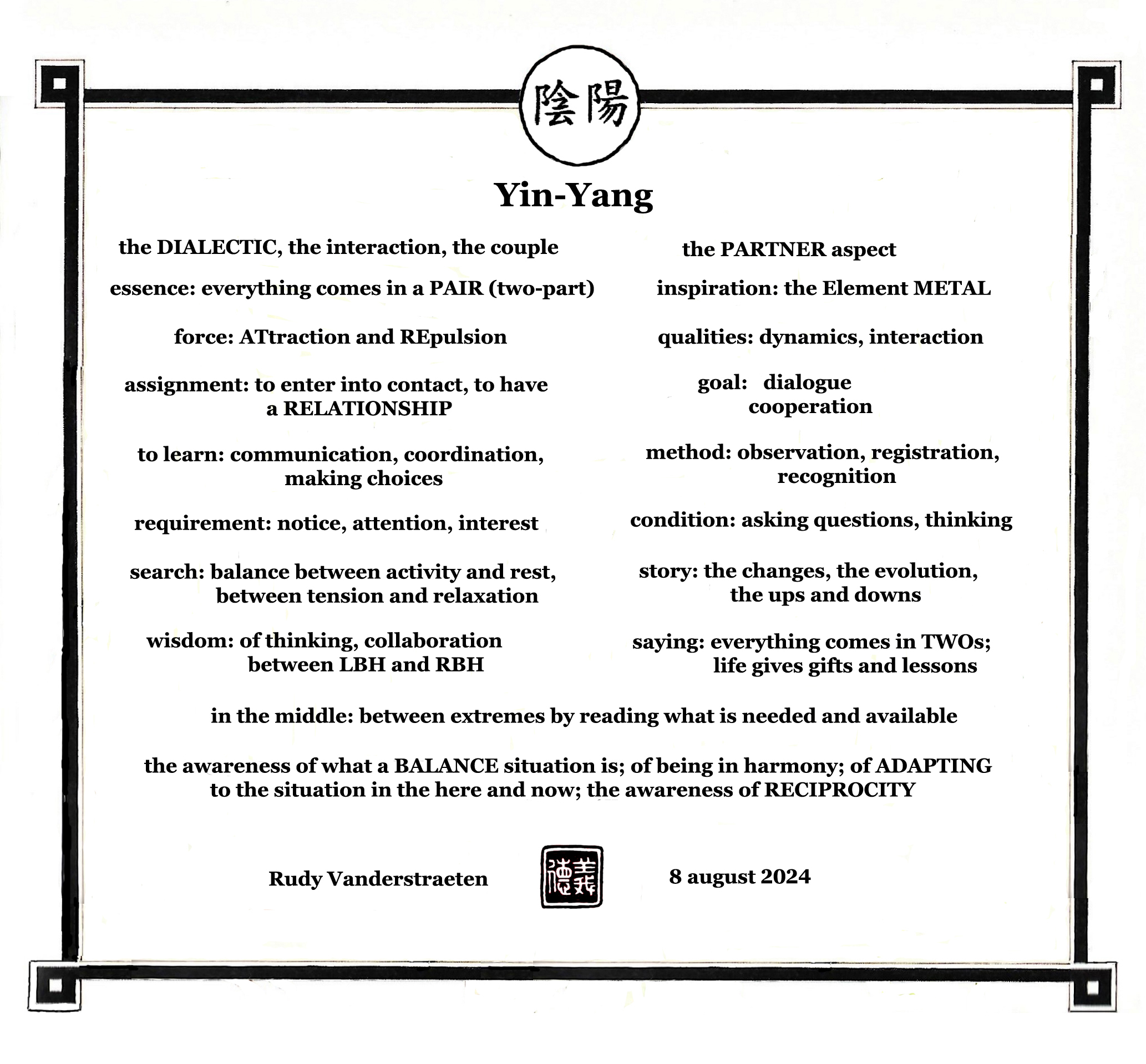Part 1
The modern Taoisme 2.0 (part 1)
English translation Published on 15 august 2024
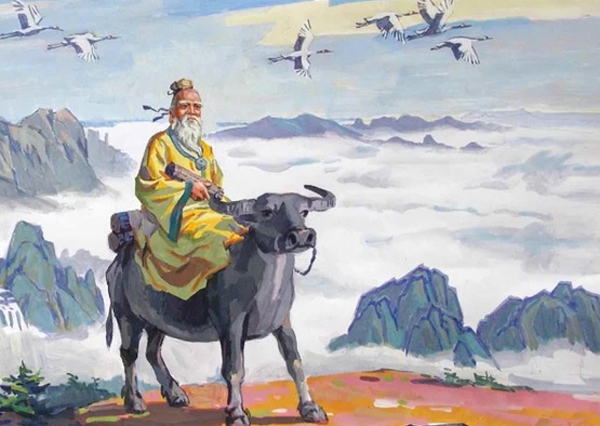
Every philosophy must remain true to its roots; for Taoism, which evolved thou-sands of years ago through various schools, movements and important historical fi-gures and thinkers, this is embedded in the Chinese culture itself. For a Westerner, this is always a bit "unfamiliar", especially when he cannot read or speak that lan-guage. On the one hand, a philosophy should not be elitist, so it should not be reser-ved for erudite sinologists who argue about what the exact translation is of one parti-cular Chinese character in a text. After all, it is about the CONTENT or the meaning of that text. On the other hand, Taoism should not be reduced to a kind of junk food by all those popularized versions of Westerners who think they have to give their own, watered down and superficial version of it. In order to maintain its integrity and impact, Taoism must be adapted to the insights that have been discovered in the meantime in two millennia of history, WITHOUT affecting or losing its authenticy.
Not an easy task. On the one hand, one must continue to regard the chapters of the Tao Te Ching as inspirational texts on which one must meditate: not just swallow them down and recite them as a kind of 10 Commandments -in reality 81(Trigrams)- of Taoism. No, one must chew them slowly mentally and carefully assimilate them bit by bit. On the other hand, one must then translate them -in terms of content- to situations and problems of today, instead of those of 3000 years ago. Many will be very opposed to adaptations or "extensions" for fear that Taoism would then lose its own character, and prefer to stick to the known tradition. But Taoism itself descri-bes reality and the world precisely as subject to a continuous process of change; thus this also applies to itself. One can argue, by the way, that this actually happened several times over the course of 3,000 to 2,000 years ago.
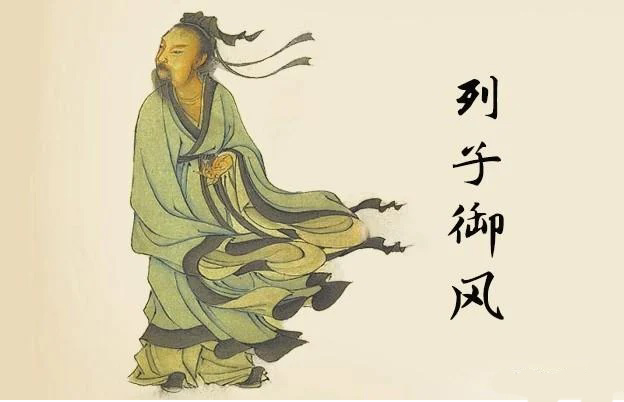
There are actually four ancient texts that qualify as the original sources of Taoism.
The first is the I Ching or the Book of Changes which belonged to the "Five Clas-sics", with its 64 hexagrams between yin and yang. It was not only used as a "book of wisdom" but also as an "oracle book": it contains the method of predicting with the help of yarrow stalks or coins what one would get on one's path in life, and with commentary on the best attitude to adopt for this. There was also the School of Yin-Yang or of the "Chinese Naturalists" who first nicely put the concepts of yin and yang and the Five Elements on the map; its most important figure was Zou Yan. This "branch" was absorbed quite quickly by the magical-alchemical direction of Taoism or incorporated into the development of Traditional Chinese Medicine (TCM).
And then there are the writings of the 3 figureheads of Taoism, in chronological order: Liezi, Zhuangzi and Laozi.
The most famous is Lao Tzu with his Tao Te Ching; the fact that he was later "deified" in China in religious Taoism as a "Heavenly Master" will probably have played a big part in that. Loazi is the most "mystical" and "meditative" of the 3, and emphasizes unification with the Tao, pure emptiness (as a condition for inner pea-ce), the archaic "as above, so below" (as a socio-political implication), "acting with-out striving for anything" as wu wei with water as its symbol. He is also today the most quoted author in all kinds of (appropriately or inappropriately) used quotes, so that many see him as the embodiment of Taoism and make the mistake of identifying Taoism only with his statements. Loazi on his buffalo is of course an image that ap-peals to the imagination.
The Liezi is considered the most accessible Taoist text: it contains many allegory stories and parables about life and deals with a variety of themes. The key concept is Ziran - the spontaneity or artlessness: freeing oneself from the thought systems im-posed by the outside world in order to live in a natural way. Liezi represents a more "human" attitude towards the world by emphasizing the cultivation of inner virtue and wisdom, rather than escaping worldly problems through detachment and dis-connection. By learning to be in a deeper connection and harmony with nature, we are guided by our inner compass and our lives gain more purpose and meaning.
Zhuangzi was the most poetic and radical of the 3: certainly anti-conformist, scep-tical, nihilist and sometimes even anarchist, he takes aim at Confucianism, the cult of form and the religion of sacrifice. He opposes thinking in categories and systems, and opts for a simple life far from government and status. He preferred to go on wanderings with his students, conversing with people from all walks of life. His wri-tings consist of parables, myths, metaphors and paradoxes in which he humorously "plays" not only with language but also with concepts themselves. That is also why people make associations with Zen Buddhism. In any case, he challenges to think outside the box, and sows confusion with his bold comparisons and abrupt leaps of thought. The most famous fragment is the Butterfly Dream: when, after having dreamed of being a butterfly, he no longer "knows" upon waking whether he was a human dreaming of being a butterfly, or a butterfly dreaming of being a human.
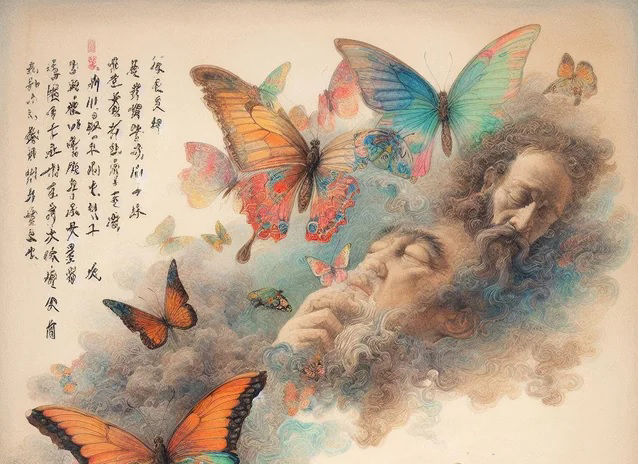
During my moderatorship of a site about Taoism on Facebook, it became clear to me how many wrong ideas and representations about Taoism exist among people who are nevertheless "interested" in it. This is partly due to the mental laziness of people, who are used to picking out anything in a supermarket according to their own pre-ferences; it is a facet of the consumer society that emphasizes precisely this in order to stimulate sales. That is why people think that they can do exactly the same on the spiritual level: they go shopping at the various -isms -the "departments" of the spi-ritual department store- and pick out what "pleases" them or convenes them. Many Westerners feel attracted to Taoism for the wrong reasons: they project their desire for more unbridled freedom, for less effort and for less self-discipline into it. As a re-sult, so much NONSENSE and nonsense is aired in so-called mémé's and one-liners that is sold as "Taoism" by anyone who comes along, under the guise that according to Taoism one "cannot make mistakes". Populism at its peak: EVERYTHING is per-mitted. However, self-discipline and respect for authority are so "ingrained" in Chinese culture that they are considered self-evident and therefore should not be mentioned as a point of the doctrine. The EARTH principle will only be touched upon indirectly as a commentary, as for example "Talking is cheap; it's the doing that counts" in the practice of some discipline. Or as the preference for simplicity and humility. To make a long story short: in order to put an end to all this "self-service", it is necessary to finally visibly map out this silent Earth aspect, which nevertheless runs like a red thread through the Taoist texts, as a separate principle on it own.
Actually, I also find that this is completely in resonance with Taoism: Chinese culture recognizes five (Eastern) Elements, so it is correct in analogy that there would also be five Taoist principles, 5 pillars: Tao, Yin-Yang, Ziran, Wu Wei and ..... Complete-ness. It also allows for the other principles to be better "encompassed" as a gestalt instead of as separate "definitions". I explain this: Chinese, as writing, as culture, as thinking, is above all the product of right-brain-hemisphere thinking. The Chi-nese characters are total images, which can get other "meanings" depending on their context. Western languages are more left-brain oriented: as fixed words with which one makes analytical sentences like puzzle pieces. Chinese thinking will therefore be less inclined to give syntheses, since a character ALREADY is a "synthesis" (total image) in itself (by itself!!). The old texts then illustrate these "self-evident" general principles with stories, situations or conversations. What rational systematic thin-king can do for Taoism is to better map out these 5 principles. Not "rewrite" Taoism to make it more accessible to rationally thinking Westerners, because it is already "pulled to pieces" enough by that. But to help from within to better describe the 5 Taoist principles in their various aspects and nuances. With respect for their origin, to give them a new language by making them more manageable for modern thinking.

The Tao or Dao (the Heavenly aspect)
Chapter 1 or Tetragram 1 of the Tao Te Ching is about the most quoted text of Tao-ism. But given its hermeticism, it is also the most misunderstood. First common mistake: one does not make the distinction between literal and figurative. One takes the "message" not to speak about the concept of Tao too literally, and therefore does not dare to say anything sensible about it, except to simply repeat the entire chapter 1. The unspeakability that results from this has shrouded the concept even more in the mist of mystery. Result: no one dares to "explore" the concept; the clock of Tao therefore stood still 2000 years ago.
However, I keep repeating that Tetragram 1 is about yang-yang-yang-yang. It is the creation story of how from Nothing Everything arose: the Big Bang, the source or the origin of life, the world and reality. The spark of life that gives the life force or Chi at birth, and extinguishes it again at death. Tao is the Life Stream, the ultimate and highest reality that nourishes and destroys all life. It presents man with the task of walking his path in accordance with this Life Stream, without losing sight of his OWN core. Preserving and developing one's own autenticity is called self-reali-sation in psychology. Passive is certainly not that, because one should not undergo "Fate", but plot one's course OWN with the compass that one has; one's intuition. One has one's self that is connected with that primal source, and one's con-sciousness to "understand" this as insights. Truthfulness, sincerity and purity are not separate values that have arisen from a kind of doctrine, but necessities to let that connection work purely.
Now, these are things that the ancient Chinese simply did not know 2000 years ago, and therefore could not interpret or "explain". Chinese Astrology has also developed more practically in the Chinese timekeeping and calendar time, and shamanistically with 12 Totem animals; held hostage as it was by the fact that the Planets were "re-served" for the imperial family, Chinese astrology has never been able to interpret the specific heavenly energy of a certain moment, represented by the positions of the Planets and the aspects they make with each other. Observations that brought insights into OTHER cultures about the analogy of the rise of a certain Planet on the horizon, and certain events on Earth. Or with certain character traits of people who were born at that particular moment. The connection between the Celestial and Earthly reality or order. What was interpreted, but not connected to Tao and Fire, was the riding of the dragon; a risky business becau-se "on horseback" on the hinge between life and death. The search to be in the eye of the hurricane, the only place of essential rest. This was later further developed by Zen as the Zen of archery: finding the exact moment to be one with the action. This also applies to other activities: the Zen of cleaning temple steps and other cho-res (Shaolin monks), of motorcycling (a bestseller in the sixties), of making sand-wiches (the film "Diva"), .......
Chapter 1 or Tetragram 1 of the Tao Te Ching is about the most quoted text of Tao-ism. But given its hermeticism, it is also the most misunderstood. First common mistake: one does not make the distinction between literal and figurative. One takes the "message" not to speak about the concept of Tao too literally, and therefore does not dare to say anything sensible about it, except to simply repeat the entire chapter 1. The unspeakability that results from this has shrouded the concept even more in the mist of mystery. Result: no one dares to "explore" the concept; the clock of Tao therefore stood still 2000 years ago.
However, I keep repeating that Tetragram 1 is about yang-yang-yang-yang. It is the creation story of how from Nothing Everything arose: the Big Bang, the source or the origin of life, the world and reality. The spark of life that gives the life force or Chi at birth, and extinguishes it again at death. Tao is the Life Stream, the ultimate and highest reality that nourishes and destroys all life. It presents man with the task of walking his path in accordance with this Life Stream, without losing sight of his OWN core. Preserving and developing one's own autenticity is called self-reali-sation in psychology. Passive is certainly not that, because one should not undergo "Fate", but plot one's course OWN with the compass that one has; one's intuition. One has one's self that is connected with that primal source, and one's con-sciousness to "understand" this as insights. Truthfulness, sincerity and purity are not separate values that have arisen from a kind of doctrine, but necessities to let that connection work purely.
Now, these are things that the ancient Chinese simply did not know 2000 years ago, and therefore could not interpret or "explain". Chinese Astrology has also developed more practically in the Chinese timekeeping and calendar time, and shamanistically with 12 Totem animals; held hostage as it was by the fact that the Planets were "re-served" for the imperial family, Chinese astrology has never been able to interpret the specific heavenly energy of a certain moment, represented by the positions of the Planets and the aspects they make with each other. Observations that brought insights into OTHER cultures about the analogy of the rise of a certain Planet on the horizon, and certain events on Earth. Or with certain character traits of people who were born at that particular moment. The connection between the Celestial and Earthly reality or order. What was interpreted, but not connected to Tao and Fire, was the riding of the dragon; a risky business becau-se "on horseback" on the hinge between life and death. The search to be in the eye of the hurricane, the only place of essential rest. This was later further developed by Zen as the Zen of archery: finding the exact moment to be one with the action. This also applies to other activities: the Zen of cleaning temple steps and other cho-res (Shaolin monks), of motorcycling (a bestseller in the sixties), of making sand-wiches (the film "Diva"), .......
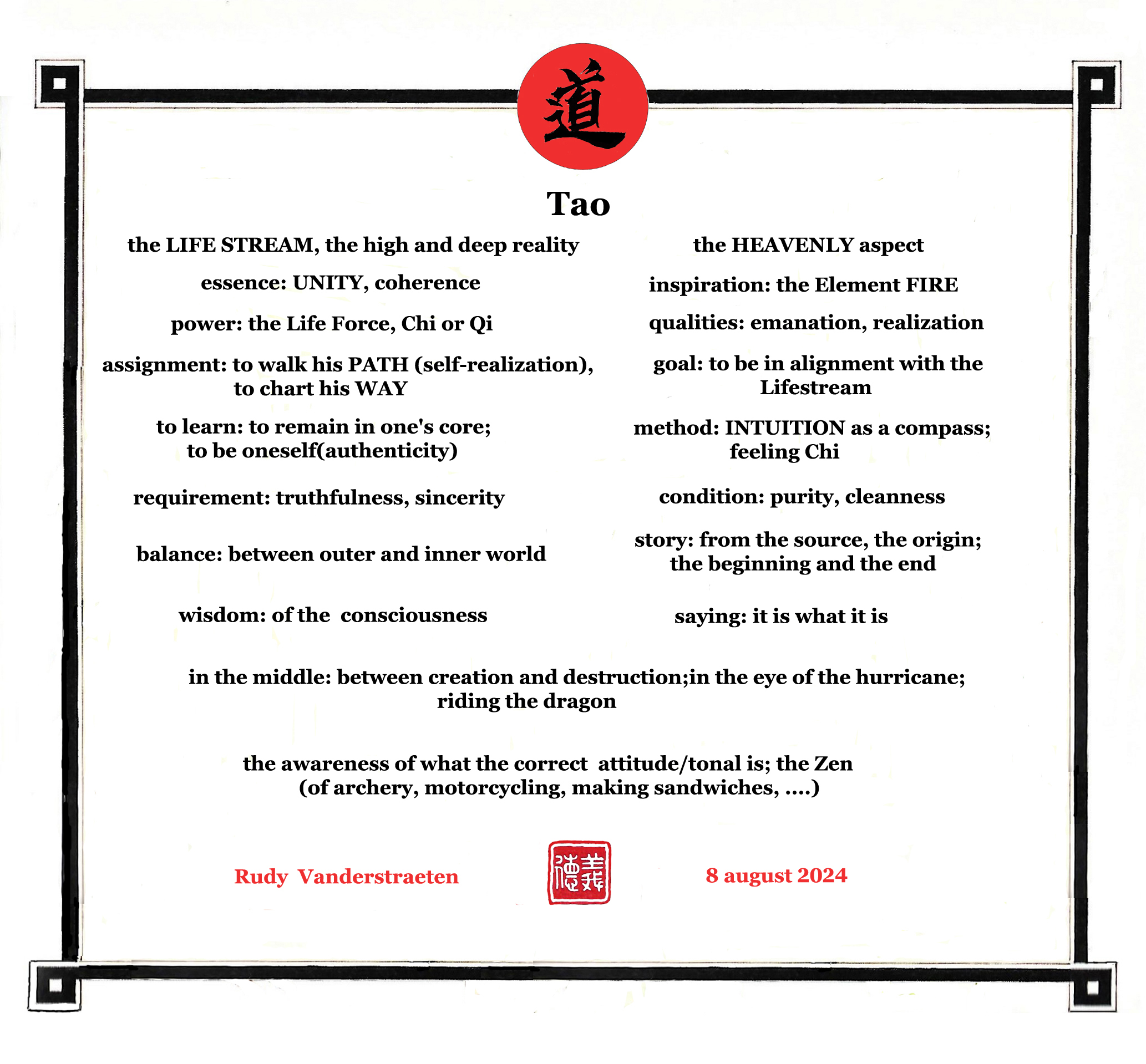
Yin-Yang (the aspect of Relationships)
The couple Yin-Yang makes the great and "incomprehensible" Lifestream or Tao vi-sible and understandable. As complementary forces they cannot exist without each other and they always occur in a variable and changeable combination. Changes that can be observed and experienced as large and small cycles and recur-ring fluctuations in the world, nature and man. The beautiful and unique thing about this is that one has succeeded in expressing a duality (one leads to two), but at the same time a dynamic relation-ship. Compare that with the weak imitation of it that "modern Non-dualism" has made: a static "obligation" to live and think in a one-si-ded and artificial "unity". No, thank you! The famous Taoism's ability to put things into perspective has its roots HERE, and not in Wu Wei. The fact of always being in a relationship means that one must constantly adapt and adjust. As a surfer on the waves or as a tightrope walker in the air, one must constantly find one's center again, in order to absorb the changes and remain standing. This gives flexibility and agility: the ability to deal with all possible changes.
In order to deal with changes in a timely manner, it is necessary to be able to notice, register and recognise them in a timely manner. One must be able to focus one's at-tention on them. Paying attention to others implies a willingness to talk together and to cooperate. Being able to talk, to dialogue and to reach compromises, agreements or an agreement are important qualities for having a good interaction or relation-ship. In practice, having a good balance in life means maintaining a good balance be-tween activity and rest, between tension and relaxation. Being able to "read", inter-pret and coordinate all of this takes place as mental attention and thinking: the collaboration between the Left and Right hemispheres of the brain. This may come as a surprise, because Taoism and Buddhism are known for not advocating the cere-bral approach: stop thinking! For Taoism this is true from the Fire aspect (Tao) and the Water aspect (Wu Wei), but NOT from the Yin-Yang (Metal aspect). That is pre-cisely why it is necessary to highlight the different aspects of Taoism: to be able to nuance and not to generalize.
One can further note that the realization that there are always TWO sides to every life phenomenon, teaches one to deal better with ALL life facets and problems. Positive and negative are like the proverbial sides of one coin. Life does not only contain nice and pleasant things, but also unpleasant and annoying things. Life does not only bring gifts, but also problems and lessons. And one may hesitate and doubt when one is at a crossroads or a conflict, but one must not get "stuck" in it: soo-ner or later one will have to cut the rope (Metal!) and make a choice. In other words ,the yin-yang dynamic makes it clear that Taoism does not advocate non-bindingness as so many Westerners believe they can detect in it: one is responsible for the mista-kes one makes and the corrections one must make in order to be back in balance with oneself.RECIPROCITY is an important method to realize that, firstly, no one lives on an island; and secondly, that one should not do to anyone what one would not want done to oneself.
The couple Yin-Yang makes the great and "incomprehensible" Lifestream or Tao vi-sible and understandable. As complementary forces they cannot exist without each other and they always occur in a variable and changeable combination. Changes that can be observed and experienced as large and small cycles and recur-ring fluctuations in the world, nature and man. The beautiful and unique thing about this is that one has succeeded in expressing a duality (one leads to two), but at the same time a dynamic relation-ship. Compare that with the weak imitation of it that "modern Non-dualism" has made: a static "obligation" to live and think in a one-si-ded and artificial "unity". No, thank you! The famous Taoism's ability to put things into perspective has its roots HERE, and not in Wu Wei. The fact of always being in a relationship means that one must constantly adapt and adjust. As a surfer on the waves or as a tightrope walker in the air, one must constantly find one's center again, in order to absorb the changes and remain standing. This gives flexibility and agility: the ability to deal with all possible changes.
In order to deal with changes in a timely manner, it is necessary to be able to notice, register and recognise them in a timely manner. One must be able to focus one's at-tention on them. Paying attention to others implies a willingness to talk together and to cooperate. Being able to talk, to dialogue and to reach compromises, agreements or an agreement are important qualities for having a good interaction or relation-ship. In practice, having a good balance in life means maintaining a good balance be-tween activity and rest, between tension and relaxation. Being able to "read", inter-pret and coordinate all of this takes place as mental attention and thinking: the collaboration between the Left and Right hemispheres of the brain. This may come as a surprise, because Taoism and Buddhism are known for not advocating the cere-bral approach: stop thinking! For Taoism this is true from the Fire aspect (Tao) and the Water aspect (Wu Wei), but NOT from the Yin-Yang (Metal aspect). That is pre-cisely why it is necessary to highlight the different aspects of Taoism: to be able to nuance and not to generalize.
One can further note that the realization that there are always TWO sides to every life phenomenon, teaches one to deal better with ALL life facets and problems. Positive and negative are like the proverbial sides of one coin. Life does not only contain nice and pleasant things, but also unpleasant and annoying things. Life does not only bring gifts, but also problems and lessons. And one may hesitate and doubt when one is at a crossroads or a conflict, but one must not get "stuck" in it: soo-ner or later one will have to cut the rope (Metal!) and make a choice. In other words ,the yin-yang dynamic makes it clear that Taoism does not advocate non-bindingness as so many Westerners believe they can detect in it: one is responsible for the mista-kes one makes and the corrections one must make in order to be back in balance with oneself.RECIPROCITY is an important method to realize that, firstly, no one lives on an island; and secondly, that one should not do to anyone what one would not want done to oneself.
